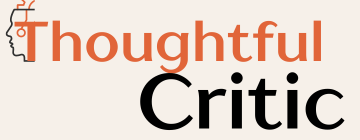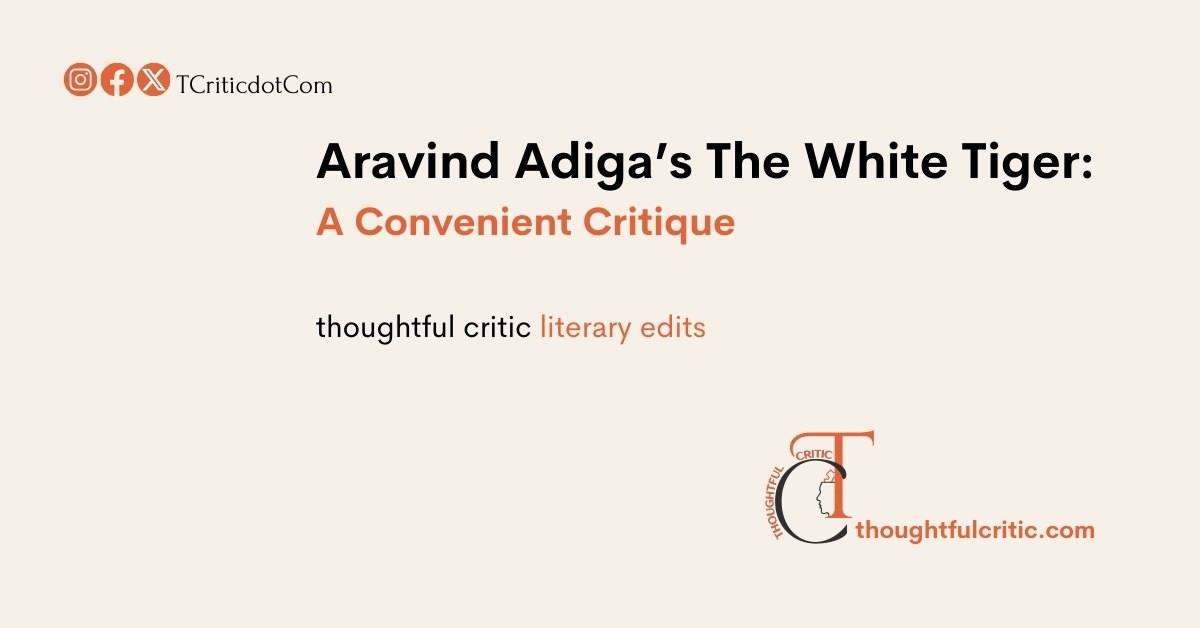Aravind Adiga’s The White Tiger is often celebrated for its sharp critique of modern India, but beneath its Booker Prize-winning acclaim lies a deeply cynical and exaggerated portrayal of Indian society—one that seems designed more to satisfy Western literary tastes than to offer a truthful representation of the nation. While the novel claims to expose the harsh realities of class struggle and corruption, it does so at the expense of reducing Indian culture to a grotesque caricature, amplifying the worst stereotypes while ignoring the complexities, resilience, and moral fabric that have sustained the country for centuries. There is no denying that India has its share of systemic injustices. Still, Adiga’s vision is so relentlessly bleak, so devoid of light or nuance, that it ceases to be social commentary and instead becomes a kind of literary exploitation—feeding the global appetite for narratives that depict India as a place of unrelenting squalor and moral bankruptcy.
Adiga’s protagonist, Balram Halwai, narrates his journey from a poor villager to a successful entrepreneur, using deceit and murder to frame his story as the inevitable outcome of India’s oppressive systems. But is this really an accurate depiction of India, or is it a sensationalised, one-sided narrative crafted to shock and provoke Western audiences? The novel leans heavily into the “poverty porn” trope, presenting India as a land where corruption is the only law, where servitude is the natural order, and where moral decay is so pervasive that even family bonds are transactional. Every institution—whether it’s the education system that fails Balram, the political machinery that thrives on bribery, or the business world that rewards treachery—is painted as irredeemably rotten. While corruption and inequality are undeniable issues in India, Adiga’s portrayal lacks any counterbalance, any glimpse of the millions who navigate these challenges with dignity, ingenuity, or even quiet resistance. Instead, he reduces an entire civilisation to a dystopian hellscape where decency is a myth and survival belongs only to the most ruthless.
What makes this portrayal particularly troubling is not that it highlights India’s flaws—many great works of literature have done so—but that it refuses to acknowledge anything beyond them. Adiga’s India is a place where every character is either a victim or a predator, where upward mobility is only possible through betrayal, and where the very concept of morality is treated as a naïve fantasy. This is not realism; it is fatalism disguised as satire. By refusing to grant his characters even the smallest measure of nobility or his society any redeeming qualities, Adiga crafts a narrative that feels less like an indictment of systemic failure and more like a wholesale condemnation of Indian culture itself. The novel’s unrelenting negativity suggests that India is not just a country with problems, but a place where decency itself is impossible. This perspective aligns disturbingly well with colonial-era stereotypes of the “backward” East.
Even more frustrating is the novel’s selective framing of globalisation and modernity. Balram’s rise is not a story of resilience or intelligence but of cold-blooded calculation, as if Adiga is arguing that in India, ethics and success are mutually exclusive. This deterministic worldview overlooks the countless real-life stories of individuals who have overcome adversity without resorting to crime, who have built businesses with integrity, or who have fought corruption without succumbing to it themselves. By presenting Balram’s moral compromises as the only logical path to success, Adiga implies that India’s poor have no agency beyond violence and deceit—a deeply patronising and reductive viewpoint. Worse still, the novel’s global appeal seems to hinge on this very reductiveness, offering Western readers the comfort of a familiar narrative: that the developing world is a Hobbesian jungle where civilisation has yet to take root.
A Western-Friendly Condemnation
One cannot ignore the fact that The White Tiger was consciously crafted for a global, primarily Western, literary market, as its exaggerated darkness and reductive portrayal of Indian society align too conveniently with Orientalist tropes of the “exotic, chaotic East” that have long dominated Western perceptions. The novel’s unrelenting focus on corruption, violence, and moral degradation, while overlooking India’s complex social fabric, cultural resilience, and ongoing struggles for reform, suggests a narrative strategy designed to confirm rather than challenge Western preconceptions about the developing world. This selective representation fits neatly into what postcolonial scholars have identified as the “third-world misery” genre—works that gain international acclaim by presenting poverty and dysfunction as inherent cultural traits rather than historical and systemic challenges. By framing India as a society where hope is fundamentally delusional and ethical behaviour inevitably leads to victimisation, Adiga perpetuates a fatalistic worldview that resonates with Western audiences accustomed to seeing the Global South through the lens of perpetual dysfunction. While such portrayals may win literary accolades abroad by satisfying expectations of what “Indian literature” should look like—dark, despairing, and fundamentally Other—they ultimately fail to engage with the nation’s lived realities, where millions navigate systemic challenges with dignity, where social movements continually push for change, and where moral complexity exists beyond the binary of ruthless oppressors and helpless victims. The novel’s international success thus raises uncomfortable questions about whether its critical reception says more about Western appetite for dystopian portraits of the East than about the actual merits of its social commentary.
“Every day, on the roads of Delhi, some chauffeur is driving an empty car with a black suitcase sitting on the backseat. Inside that suitcase is a million, two million rupees; more money than that chauffeur will see in his lifetime. If he took the money he could go to America, Australia, anywhere, and start a new life (98).”
“I talked to him about the wisdom of my village—half repeating things I remembered Granny saying, and half making things up on the spot—and he nodded. It was a scene to put you in mind of that passage in the Bhagavad Gita, when our Lord Krishna—another of history’s famous chauffeurs—stops the chariot he is driving and gives his passenger some excellent advice on life and death. Like Krishna I philosophized—I joked—I even sang a song—all to make Mr. Ashok feel better (105).”
Conclusion: A Missed Opportunity
There is no denying that India has deep-rooted problems—corruption, caste discrimination, economic disparity—but The White Tiger does not offer a meaningful critique. Instead, it indulges in hyperbole, presenting Indian culture as inherently broken. A truly great novel would strike a balance between criticism and humanity, showing both the flaws and the potential for change. Adiga’s work, however, settles for shock value over substance, leaving readers with a distorted and ultimately unfair portrayal of a nation far more complex than he allows.
If literature is meant to provoke thought, then The White Tiger succeeds only in provoking outrage, not at the injustices it claims to expose, but at its own reductive and derogatory vision of India. The White Tiger is less a mirror held up to India than a funhouse distortion—one that magnifies the ugliest facets while erasing everything else. A truly great novel would balance its critique with humanity, allowing for both condemnation and hope, as well as despair and resilience. But Adiga’s vision is so unrelentingly dark that it ceases to feel like literature and instead becomes a kind of ideological manifesto, one that insists India is beyond redemption. That may make for provocative storytelling, but it does little to further any fundamental understanding of the nation—its struggles, its strengths, or its people.
Alok Mishra for Thoughtful Critic

